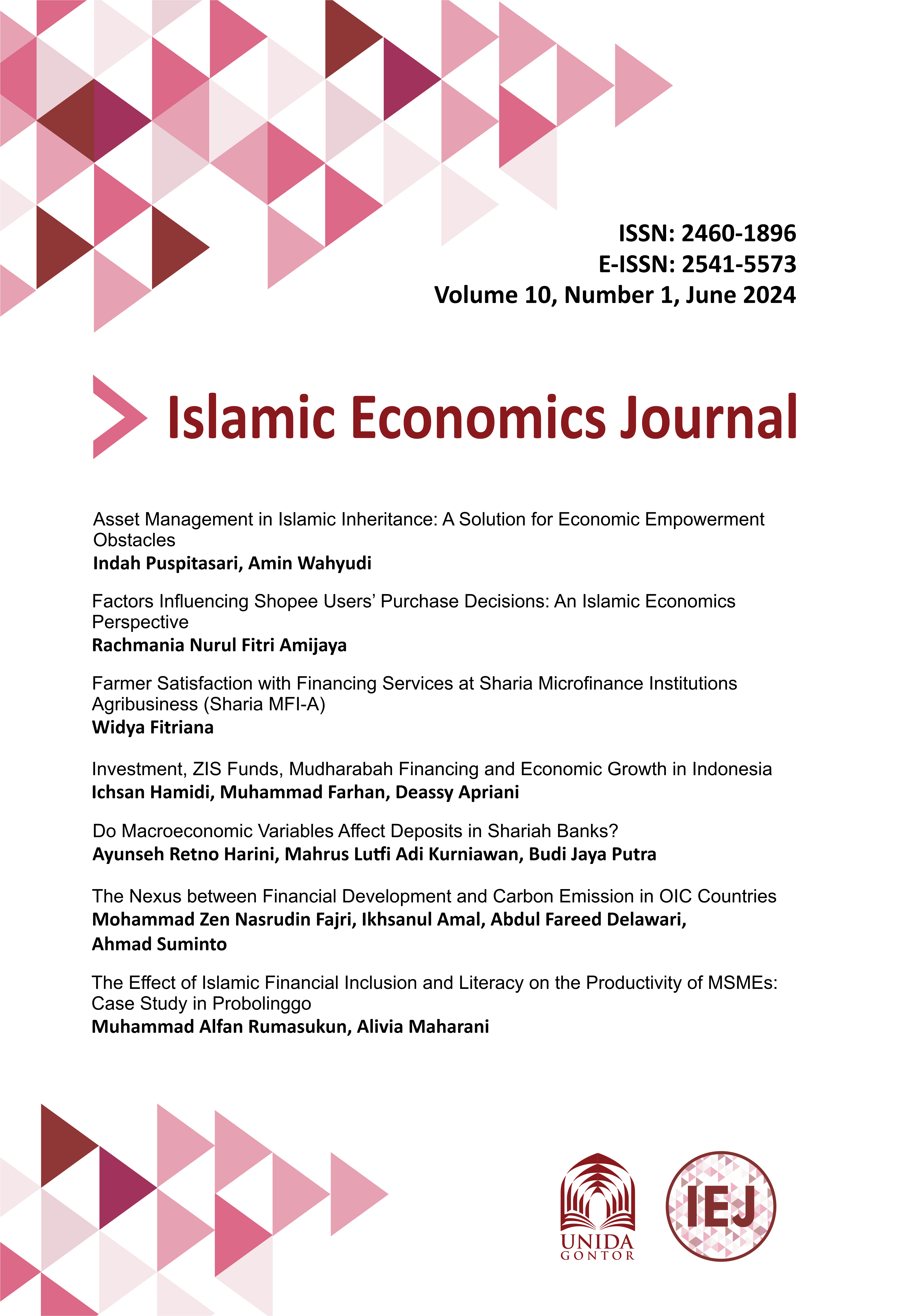Do Macroeconomic Variables Affect Deposits in Shariah Banks?
DOI:
https://doi.org/10.21111/iej.v10i1.11611Abstrak
Banks are intermediary institutions that collect funds from the public and channel them back in the form of credit and the funds collected are third party funds (TPF) which are the largest source of funds relied on by banks, including sharia banking. The challenge of sharia banking is to expand market share. Currently in Indonesia the banking market share is dominated by conventional banking. Increasing market share will increase savings in sharia banking and strengthen sharia banking as an intermediation institution. The research aims to identify the influence of macroeconomic variables on deposits in sharia banking. The research uses time-series data 2012: Q1 - 2022: Q1 and the ARDL method to estimate the short- and long-term influence of macroeconomic variables on TPF. The research results show that there are two variables that influence the short and long term, namely the GDP variable and the exchange rate. Meanwhile, inflation and interest rate variables only have an effect in the short term. The implications of the research show that increasing economic growth must be followed by increasing people's income and the stability of the rupiah exchange rate will increase people's deposits or savings in sharia banking.Referensi
Afrida, Y, and R Iskandar. “Pengaruh Inflasi, Kurs, Tingkat Suku Bunga, Pertumbuhan Ekonomi, dan Jumlah Uang Beredar terhadap Jumlah DPK Bank Syari’ah.†Maqdis: Jurnal Kajian Ekonomi Islam. Vol. 3, No. 2, (2018).
Akhanolu, Isibor Areghan, Omankhablen Alexander Ehimare, Chima Menyelim Mathias, Komolafe Titilope Deborah, and Okereke Karachi Yvonne. “The Impact of Credit Risk Management and Macroeconomic Variables on Bank Performance in Nigeria.†WSEAS Transaction on Business and Economics, (2020).
Anwar, S. M, J Junaidi, S Salju, R Wicaksono, and M Mispiyanti. “Islamic Bank Contribution to Indonesian Economic Growth.†International Journal of Islamic and Middle Eastern Finance and Management. Vol. 13, No. 3, (2020).
Areghan, Sibor, Omankhanlen Alexander, Chima Menyelim Mathias, Komolafe Titilope Deborah, and Okereke Karachi Yvonne. “The Impact of Credit Risk Management, Macroeconomic Variables on Bank Performance in Nigeria.†Journal of Legal, Ethical and Regulatory Issues. Vol. 24, No. 1, (2021).
Arif, M Nur Rianto Al. “Spin-off and Its Impact on the Third Party Funds of Indonesian Islamic Banking Industry.†Economic Journal of Emerging Markets. Vol. 6, No. 1, (2014).
Choiriyah, Choiriyah, Saprida Saprida, and Emilia Sari. “Development of Sharia Banking System in Indonesia.†Mizan: Journal of Islamic Law. Vol. 5, No. 1, (2021). https://doi.org/10.32507/mizan.v5i1.923.
Dendawijaya, Lukman. Manajemen Perbankan. Jakarta: Ghalia Indonesia, 2009.
Effendi, Jaenal, and Nurkholis Yasmin. “The Effect of Internal and External Factors of Banking to the SMEs Financing for BPRS in Indonesia.†Jurnal Keuangan dan Perbankan. Vol. 21, No. 3 (2017).
Ferdiansyah, Nurazlina, and Eka Hariyani. “Pengaruh Rate Bagi Hasil dan BI Rate terhadap Dana Pihak Ketiga Perbankan Syariah (Studi pada Bank Pembiayaan Rakyat Syariah yang Terdaftar di Bank Indonesia).†Jurnal Online Mahasiswa Fakultas Ekonomi. Vol. 2, No. 1, (2015).
Firdausi, Iqbal. “Analisis Pengaruh Kinerja Perbankan terhadap Dana Pihak Ketiga Bank Persero.†Jurnal Keuangan dan Perbankan. Vol. 20, No. 3, (2016).
Gadou, Lamnya M A. “Banking Risk in Selected MENA Countries.†International Journal of Innovative Research and Scientific Studies. Vol. 5, No. 4, (2022).
Grediani, Evi, Nanik Niandari, and Rahmawati Y Hanny. “Empirical Analysis of Depositor Funds Determinants in BPRS in Indonesia.†International Journal of Business Management and Economic Research (IJBMER). Vol. 9, No. 4, (2018).
Hafizh, M, N Hidayah, and P. R Silalahi. “Macroeconomics and Profit Sharing Financing in Islamic Banking in Indonesia: The Third Parties Fund as Intervening.†Jurnal Akuntansi dan Keuangan Islam. Vol. 8, No. 2, (2020).
Haron, S, and W. N. W Azmi. “Determinants of Islamic and Conventional Deposits in the Malaysian Banking System.†Managerial Finance. Vol. 34, No. 9, (2008).
Ilyas, Rahmat. “Manajemen Permodalan Bank Syariah.†BISNIS: Jurnal Bisnis dan Manajemen Islam. Vol. 5, No. 2, (2017).
Indiastary, Diyas, Noven Suprayogi, and Imam Wahyudi Indrawan. “A Meta-Analysis of the Determinant of Third Party Fund on Islamic Banking in Indonesia.†JEBIS: Jurnal Ekonomi dan Bisnis Islam. Vol. 6, No. 2, (2020).
Junaeni, Irawati, Dian Kurniawati, Ridarmelli, and Muhammad Iqbal. “Efforts to Increase the Growth of Islamic Bank Financing by Deversifying the Right Financing Types.†International Journal of Professional Business Review. Vol. 8, No. 4, (2023).
Kapinos, Pavel, and Oscar A Mitnik. “A Top-down Approach to Stress-Testing Banks.†Journal of Financial Services Research. Vol. 49, No. 2–3, (2016).
Kasmir. Analisis Laporan Keuangan. Jakarta: Rajawali Pers, 2012.
Kurniawan, Mahrus Lutfi Adi, Indanazulfa Qurrota A’yun, and Winny Perwithosuci. “Money Demand in Indonesia: Does Economic Uncertainty Matter?.†Jurnal Ekonomi dan Studi Pembangunan. Vol. 23, No. 2, (2022).
Kurniawan, Mahrus Lutfi Adi, and Uswatun Khasanah. “Determinant of Property Price through the Monetary Variables: An ARDL Approach.†Jurnal Ekonomi Pembangunan: Kajian Masalah Ekonomi dan Pembangunan. Vol. 24, No. 1, (2023).
Marcu, M. R. “The Impact of the Covid-19 Pandemic on the Banking Sector.†Management Dynamics in the Knowledge Economy. Vol. 9, No. 2, (2021).
Mumtazah, Wardati, and Dina Fitrisia Septiarini. “Analisis Faktor-Faktor yang Mempengaruhi Jumlah Dana Pihak Ketiga pada Bank Umum Syariah di Indonesia (Periode Triwulan I 2010 - Triwulan I 2015).†Jurnal Ekonomi Syariah Teori dan Terapan. Vol. 3, No. 10, (2016).
Nastiti, N. D, and R. A Kasri. “The Role of Banking Regulation in the Development of Islamic Banking Financing in Indonesia.†International Journal of Islamic and Middle Eastern Finance and Management. Vol. 12, No. 5, (2019).
Olimov, Sayakhmad, Abdul Hamid, and Muhammad Arief Mufraini. “Performance of Depositor Fund: A Lesson from Indonesian Islamic Banking System.†Etikonomi Jurnal Ekonomi. Vol. 16, No. 1, (2017).
Pesaran, M. H, Y Shin, and R. J Smith. “Bounds Testing Approaches to the Analysis of Level Relationships.†Journal of Applied Econometrics. Vol. 16, No. 3, (2001).
Prasetya, Bambang, Syamsurijal Tan, and Arman Delis. “Faktor-Faktor yang Mempengaruhi Penghimpunan Dana Pihak Ketiga Perbankan Syariah di Indonesia.†Jurnal Perspektif Pembiayaan dan Pembangunan Daerah. Vol. 3, No. 2, (2015).
Seftarita, Chenny, Ferayanti, Fitriyani, and Asri Diana. “Fiscal and Monetary Policy, Trade Openness, and Its Impact on Indonesian Exchange Rate.†In 2020 International Conference on Decision Aid Sciences and Application, DASA 2020, (2020).
Sukirno, Sadono. Ekonomi Pembangunan: Proses, Masalah, dan Dasar Kebijakan. Jakarta: Kencana Prenada Media Group, 2006.
Suyatno, Thomas. Kelembagaan Perbankan. Jakarta: PT. Gramedia Pustaka, 2007.
Syasya, Putri Herma, Universitas Islam, Negeri Sultan, Aji Muhammad, Idris Samarinda, Fitria Rahmah. “Pengaruh Jumlah Kantor, Inflasi, Nilai Tukar, Suku Bunga, dan PDB terhadap DPK pada Bank Umum Syariah di Indonesia Periode 2017-2022â€. Vol. 2, No. 1, (2023).
Widodo, Arief, and Mahrus Lutfi Adi Kurniawan. “Comparing Credit Procyclicality in Conventional and Islamic Rural Bank: Evidence from Indonesia.†Al-Tijary: Jurnal Ekonomi dan Bisnis Islam. Vol. 3, No. 1, (2018).
Zerihun, Mulatu Fekadu. “Internal Determinants of Bank Deposit Flows under Different Market Conditions in Ghana.†Banks and Bank Systems. Vol. 19, No. 1, (2024).
##submission.downloads##
Diterbitkan
Terbitan
Bagian
Lisensi
Hak Cipta (c) 2024 Islamic Economics Journal

Artikel ini berlisensiCreative Commons Attribution-ShareAlike 4.0 International License.







